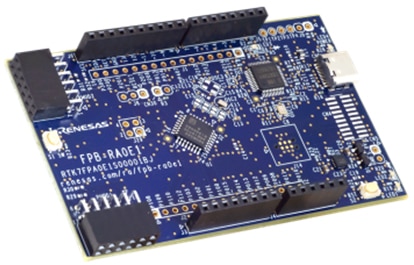Renesas RA0E1 MCU 轻松化解价格与性能方面的设计挑战
投稿人:DigiKey 北美编辑
2024-10-30
对于电子应用而言,若想在审批时获得「绿灯」并成功完成开发,可能就要对成本锱铢必较。这就是为什么工程师在选择合适的微控制器单元 (MCU) 时,经常会面临艰难的挑战,他们需要在性能与价格之间寻求平衡点。为了让选择变简单,Renesas Electronics Corporation 面向成本敏感型嵌入式应用推出了一款基于 Arm® 的超低功耗 MCU。
为了开发高能效、低成本的应用,工程师面临着难以想象的压力。竞争问题、消费者和企业客户的期望,以及快速的创新步伐,这些全都会增加因对成品成本或 MCU 性能的轻微误判而导致失败的风险。
MCU 只是一个组件,但对确定系统总成本至关重要。如果每件产品的价差为 50 美分,则在计划生产 100,000 件最终产品的情况下,可能会额外增加 50,000 美元成本。
这还可能只是冰山一角:除了 MCU 的实际单位成本外,开发人员还必须考虑各种可能影响项目预算的潜在隐性成本因素,例如:
- 软件工具和开发环境的许可费用
- 培训时间
- 测试和故障排除
- 外围元器件需求
- 固件开发
- 电源管理
- 合规和认证
对于生产量较小的产品,虽然 MCU 的价差可能不会导致成本增加很多,但由于生产单位数量较少,相关的额外成本往往会相对更高。这可能使项目获批成为泡影。
功耗和热管理会使选择合适的 MCU 变得更加复杂。
MCU 的功耗越大,设计人员就越有可能需要为移动和便携式应用配备额外元器件和可能更昂贵的电池。类似地,功耗越大,产生的热量就越多,因此可能还需要额外的冷却技术。
没有人愿意为性能超出需求的元器件支付过高的价格。但是,他们也不希望创造的应用在部署时表现不佳。因此,实现成本与性能之间的最佳平衡决定着应用的成败。
实现最佳平衡
MCU 的选择显然必须符合计划应用的具体特性和功能要求。除此之外,还需要符合预算要求,价格敏感型应用尤为如此。这就需要找到性能、功耗和集成外设的最佳组合。
在价格方面,有些应用更加敏感。例如,家用物联网设备往往面临激烈的价格竞争压力,这反映了消费者对低成本设备的期望。工业自动化应用通常需要更坚固耐用、可靠性更高的设备,以便在无人值守的情况下使用,但仍然很可能在价格和其他考虑因素方面面临竞争。
要在价格和性能之间找到合适的平衡点,首先要选择合适的 MCU,既能满足性能要求,又具有高能效,还能为应用设计人员提供灵活性。
通常,高性能应用可提供更强大的处理能力、更高的时钟速度,并且能够完成更复杂的任务。这些更昂贵的 MCU 通常会加入多个集成外设,从而能够减少对附加元器件的需求,但软件开发和调试的费用往往也会更高。
为成本敏感型应用设计的 MCU 通常会存在集成外设较少、内存有限和设计灵活性较低的缺点。不过,它们也有功耗低和电池续航时间长的优点。
Renesas 针对价格敏感型应用推出了功能丰富的 MCU
为了简化低成本应用的选型过程,Renesas 推出了 RA0E1 系列 MCU,该系列 MCU 功能丰富,具有极低的功耗和经过优化的外设,为开发人员提供了一种以较低物料成本优化设计的方法。
RA0E1 MCU 采用高能效 Arm Cortex-M23 内核,不仅配备了一套出色的集成定时器,而且还具有串行通信、模拟功能以及安防和安全功能,直接面向成本敏感型应用市场。
Arm Cortex-M23 是一款入门级 32 位处理器,专为高能效运行而设计。这款 MPU 内核采用易于学习和编程的简单架构,加入了 Arm 的 TrustZone 安防技术以及调试和跟踪功能,能够诊断和优化应用,同时支持高能效低功耗模式。
RA0E1 在活动模式下的电流消耗为 84.3 μA/MHz,在睡眠模式下为 0.82 mA,因此非常适合电池供电的能耗敏感型应用。其丰富和高效的功能集适用于各种应用,包括消费电子产品、工业自动化、安全物联网设备、楼宇自动化以及小家电等。
RA0E1 的电源电压范围为 1.6 V 至 5.5 V,因此设计人员可直接在 5 V 系统中采用该器件,而无需使用电平位移器或稳压器。RA0E1 还集成了高精度片上振荡器,因此设计人员无需在设计中添加独立的振荡器。该振荡器不仅可提高波特率准确度,而且能在 -40°C 至 +105°C 的环境中保持 ±1.0% 的精度。
将多种功能集成到单个芯片中的 MCU 可大幅减少对额外元器件的需求。这种集成简化了设计,减小了 PCB 基底面,最终降低了系统总成本。为了最大限度减少外部外设,RA0E1 集成了许多元器件,包括:
- 高达 64 KB 的集成代码闪存和 12 KB 带奇偶校验位的高速 SRAM
- 模拟外设,包括 12 位 ADC、温度传感器和内部基准电压
- 通信外设,包括 3 个 UART 接口、1 个异步 UART 接口、3 个简化串行外设接口 (SPI)、1 个内部集成电路 (IIC) 以及 3 个简化 IIC
- 安全功能,包括 SRAM 奇偶校验、无效内存访问检测、频率检测、A/D 测试、不可变存储、CRC 计算器以及寄存器写保护
- 安全功能,包括唯一 ID、真随机数发生器 (TRNG) 和闪存读保护
开发环境和向上兼容性
Renesas 为开发人员提供了一个通用设计环境,即灵活配置软件包,包括生产就绪驱动程序、Azure RTOS、FreeRTOS 以及其他中间件堆栈。该软件包还为开发人员提供了将应用迁移到功能更强大的 RA MCU 的途径。
Arm 内核具有很高的兼容性。Cortex-M23 采用 Armv8-M 指令集,该指令集与其他 Cortex-M 内核架构使用的指令集兼容。
Renesas RA01E MCU 的引脚和外设与 Renesas 的 RA2E1 系列 MCU 兼容,后者搭载了 48 MHz Arm Cortex-M23 核心,并整合了高达 128 KB 的代码闪存和 16 KB SRAM。这使得基于 RA0E1 的设计能够升级到更高性能的 MCU。
Renesas 还提供了 FPB-RA0E1 快速原型开发板(图 1),用于评估、原型开发和开发基于 RA0E1 MCU 的应用。
 图 1:用于 RA0E1 微控制器应用原型开发的 FPB-RA0E1 评估板。(图片来源:Renesas)
图 1:用于 RA0E1 微控制器应用原型开发的 FPB-RA0E1 评估板。(图片来源:Renesas)
该评估板包括一个 Arduino UNO R3 接口和两个 Pmod 连接器。此外,开发人员还可以充分利用内置 SEGGER J-Link™ 仿真器电路,无需其他工具即可编写和调试程序。
结语
Renesas RA01E MCU 为开发超低功耗、成本敏感型应用提供了一系列出色的功能和集成外设,无需在价格与性能之间做出妥协。该 MCU 具有多种连接选项和丰富的生态系统,以及全面的开发环境,能够以更低的物料成本打造应用,同时还提供了后续将应用迁移到功能更强大的设备的途径。

免责声明:各个作者和/或论坛参与者在本网站发表的观点、看法和意见不代表 DigiKey 的观点、看法和意见,也不代表 DigiKey 官方政策。








